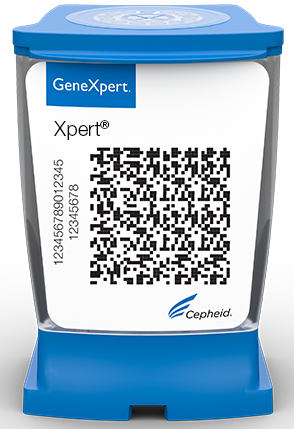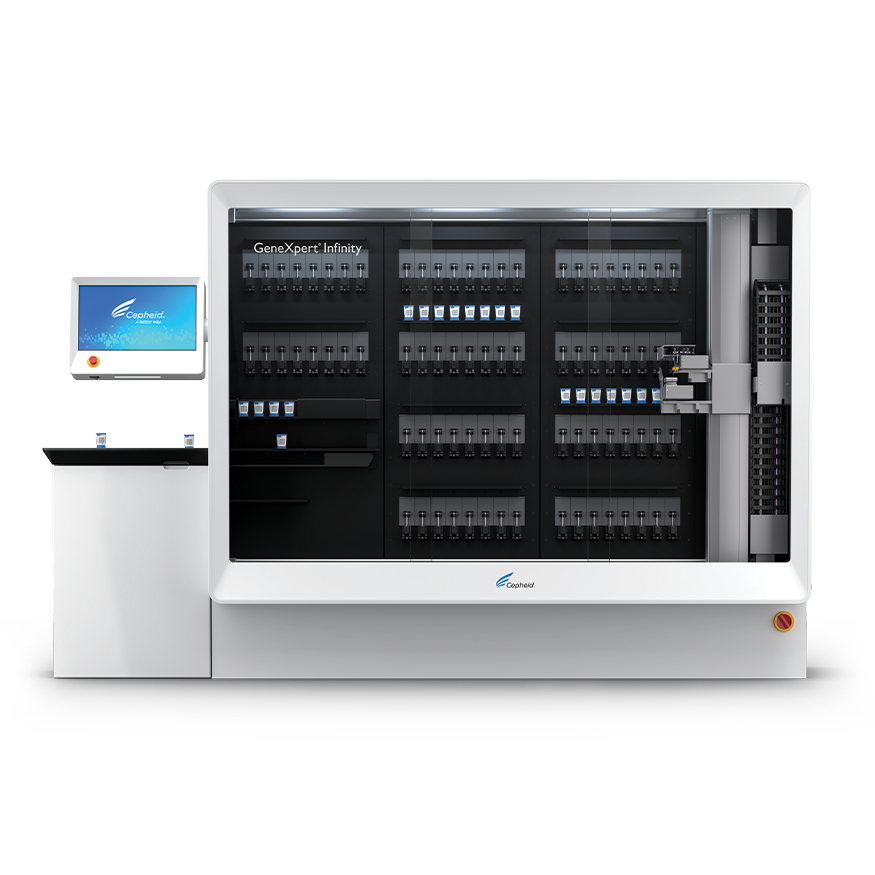One interesting bit is that GeneXpert has been around for a long time. According to the company's own history page (and of course one must expect a very bullish, Whig history on any corporate website), Cepheid was formed in 1996 and launched their first qPCR instrument, the SmartCycler, in 2000. It's a technology one can truly look up to - as in there is apparently an instrument orbiting the Earth on the International Space Station.
Cepheid followed SmartCycler up with the first GeneXpert system. Launched in 2005 but with use as early as 2003 for biothreat surveillance, a key aspect of GeneXpert is a consumable cartridge containing all the assay reagents.
As described in a company video, the top lid of the cartridge opens to enable the operator to add sample. Diagnostic samples can come in many formats, such as swabs or vials, and sample extraction (or at least disaggregation) would typically be handled upstream and then liquid containing the analyte of interest added to the cartridge and the lid snapped shut; after that there is no user intervention with the sample - all reagents required are onboard
GeneXpert cartridges snap into individual GeneXpert modules which supply the mechanical force for manipulating the cartridge interior, a thermocycling element (though some assays are isothermal), and the LED-based optics for acquiring the qPCR signal.
The mechanical piece is simple and appears robust - and GeneXpert's long track record suggests it truly is. A rod drops from the module into the cartridge and rotates the valve, then draws sample up into a plunger contained within the module. Another rotation enables access to "the active area" and lowering the plunger enables delivering sample into this zone. A filter enables capturing microorganisms for bacterial assays. In this format, another plunger-driven rotation of the valve enables washing material captured by the filter. An ultrasound transducer enables mechanical lysis of organisms. Further rotation of the valve and pushing of fluid moves it into the area with the reagent beads. Vertical movement of the plunger agitates the solution, enabling dissolution of the reagent beads.
That seems like a very clever bit of robust liquid handling - though perhaps the assays are engineered to be very tolerant of sample amounts. Compartmentalizing all the liquid operations in the disposable cartridge minimized risk of cross-contamination, though the downside is GeneXpert assays have a reputation for being as much as $50 per sample, much higher than many qPCR assays.
Another advantage of the cartridge system is it is optimal for a random stream of different assays. Each cartridge operates independently, so operators can launch one assay in one module and a wholly different one in a different module on the same instrument. Benchtop instruments appear to be sold with 2, 4, or 16 modules and then monsters of 48 or 80 modules with automation to enable queuing modules
Instrument prices appear to not be prohibitive - at least on reconditioned, used models. I found a four-module CLIA-waived instrument selling for $16.5K. Not clear how much extra "that new thermocycler smell" would run. Okay, so GeneXpert is a mature technology for qPCR that uses simple, robust automation to perform automated cell lysis and qPCR. So how does that fit with Oxford Nanopore?
First, it must be said that this is a partnership nearly unthinkable under the leadership of prior CTO Clive Brown - he hated big expensive instruments and this is a big piece of kit in his eyes. But Brown is gone as of November - an event for which I discarded multiple drafts in November and then in December had a major personal setback that erased all worries about writers block. Surely I can get back on that horse before London Calling in less than a month and a half?
Anyways, big boxes are no longer anathema with ONT - of course ElysION was already coming down the pike even before Brown left and is designed to automate the entire wetlab process from sample to sequencer loading. That's a key difference with Cepheid, at least as the system stands now: it would seem any marriage with ONT will likely end with the user extracting PCR product from a modified cartridge and then completing library preparation and loading of the sequencer outside the GeneXpert system.
If that is what the system will look like, it would still require much greater expertise than operating GeneXpert now. Perhaps click residues can be put in the primers and the library prep made very simple, or perhaps longer amplicons will be generated which are suitable for the tagmentation-based rapid prep. Maybe the new flowcells will be used which have a much easier loading port - the contortions ElysION's gantry must perform to operate the designed-barely-for-human-fingers mechanics on the classic MinION flowcells are both fascinating and painful to watch. But it seems unlikely to be the fire-and-forget fully automated workflow found on GeneXpert
Could the collaboration produce a more integrated, sample-to-answer system? Anything is possible, but the GeneXpert seems less suitable for this. The modules as they exist now appear to have little to no data connectivity and the compute required to analyze qPCR data plus some light barcode scanning is a tiny fraction of what is required to perform even simple processing of nanopore data. So it would seem unlikely that the ONT-Cepheid collaboration will produce an instrument with ElysION's complete solution - but ElysION requires a more more complex deck setup process for each run and management of multiple consumables. Plus ElysION's complex Tecan-derived gantry system is at a much greater risk of failure
Still, if ONT could sell diagnostic kits into a small fraction of the existing GeneXpert user base, that could be a very nice reward. But even that may be a stretch, given the higher training requirements. So ONT must come up with some truly compelling diagnostic content to put on the GeneXpert platform that both fits the PCR paradigm and yields significant value beyond what a simple qPCR assay can deliver.
That's already a non-trivial challenge, and ONT hasn't shown much prior ability to develop compelling diagnostic assays. London Calling is always filled with interesting ideas for such posters, but the long, slow dull road to an approved diagnostic isn't the sort of flashy content that dominates the meeting.
ONT did have their LamPORE isolthermal assay for SARS-CoV-2 - but it was never clear what the advantage of it was over the now ubiquitous and inexpensive lateral flow assays. Maybe if they had demonstrated the ability to type variants it could have been interesting, but that didn't happen.
Nor has ONT tried to convert LamPORE to other pathogens which might well fit their "sequence anything anywhere" mantra - such as plant viruses that are threats to key crops of the Global South.
Nanopore sequencing did punch far above its market weight when it came to SARS-CoV-2 sequencing using the ARTIC and Midnight (and other) protocols, with far more data generated on ONT platforms than one would expect from their market share. While SARS-CoV-2 sequencing isn't funded very well these days, there is continuing interest in surveillance of various human pathogenic viruses from wastewater and other media - and again, perhaps there is an opportunity for similar monitoring and identification of plant pathogenic viruses. But whether GeneXpert is really going to make sense in that space is an open question - particularly with the high cost of the disposable cartridges. Add those onto flowcell costs and one probably arrives at a base price that is a non-starter.
Just in partnering with Cepheid ONT is showing a new behavior. In general, ONT has stood very aloof of other companies. Sure, they'll mention or even recommend specific products that are required but not supplied (such as ligase for library preparation kits), but ONT hasn't made many partnerships with other equipment companies and certainly not big, mature companies like Danaher/Cepheid. I guess another is ElysION, which is engineered by Tecan but it would appear that all marketing of the system will be by ONT. It will be very interesting to see if the partnership with Cepheid is the leading edge of further partnerships with established companies in the genomics space, or this is a one-off and ONT goes back to its historical "go it alone" strategy.
Cepheid's GeneXpert shows one way to succeed in diagnostics: a simple-to-use diagnostic system with robust mechanics and disposable cartridges. It also illustrates the great challenges of marrying this to any sequencing technology. ONT's proposed TraxION system would start looking very much look like a cartridge-based, simple workflow system - just with the two serious issues of ONT never getting VolTRAX electrowetting technology to perform reliably and the unsolved challenge of moving libraries from the electrowetting zones to the nanopore device without manual intervention. But given the apparently healthy marketplace for new, used and refurbished GeneXpert systems, even just developing protocols for performing only sample prep on GeneXpert could inspire new applications for nanopore sequencing in public health, biosecurity and perhaps agriculture.
In a broader strategic scope, Danaher is a a major player in diagnostics and may want to counterbalance their rival Roche in having sequencing options. Danaher long ago was involved with the open source Polonator system, but hasn't played in the sequencing hardware space in forever. Danaher owns IDT, which is of course a major player in the NGS library kit space. There's some speculation on the webs that Danaher might want to make more aggressive moves into NGS systems space with an acquisition, but ONT hardly fits the usual Danaher playbook of acquiring fully established and profitable brands - ONT is established but not nearly profitable. But with Roche and ThermoFisher both owning sequencers, even if ThermoFisher's Ion Torrent brand is essentially relegated (but profitably so) to specific diagnostic niches, perhaps they are starting to have an itch to own a sequencing business. Danaher's market cap is over 10X Illumina's, so they could in theory use their stock to buy any of the players.
Like every other such announcement, the crystal ball is murky. Only time will tell whether ONT executes well on their end and what the final outcome will be.
Conflict of Interest disclosure: Due to the same event which kiboshed my writing zeal in December, I am currently in the situation of having a meaningful financial interest in Danaher. My "almost entirely index funds, own only stocks in former employers or their acquirers" investment strategy usually shields me from financial conflicts-of-interest in my writing. Later this year I hope to erase this COI, but at the moment I have it. Often that means I just would dodge writing on the topic, but this story was too interesting to avoid. But realistically, the short-term impact of the ONT deal on a diversified giant conglomerate like Danaher will be rounding error on the trading noise and my feeble writing ain't going to move that needle.


3 comments:
That is all just pure speculation.
Thinking out loud, I wonder if this ONT/Cepheid collaboration is a way to leverage the success of the Cephid Xpert MTB/RIF Assay [for diagnosis of Tuberculosis] to accelerate implementation of the ONT AmPORE-TB kits [for amplicon sequencing-based detection of mutations associated with drug-resistance in Mycobacterium tuberculosis]. If a group is already using the GeneXpert to detect TB, then it would be very convenient if the same instrument could be used to generate barcoded amplicons (or libraries) compatible with the ONT-AmPORE workflow.
Nice write up Keith, thanks. Any idea of the price? What price/TAT do you think will be required to actually see meaningful uptake?
Post a Comment